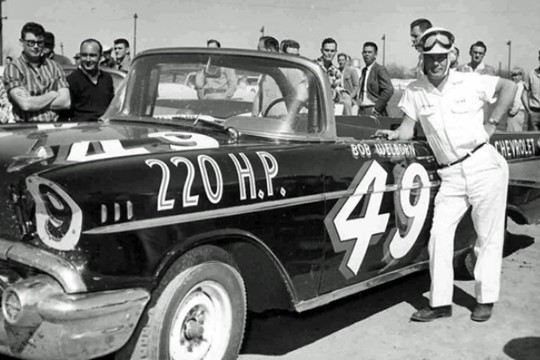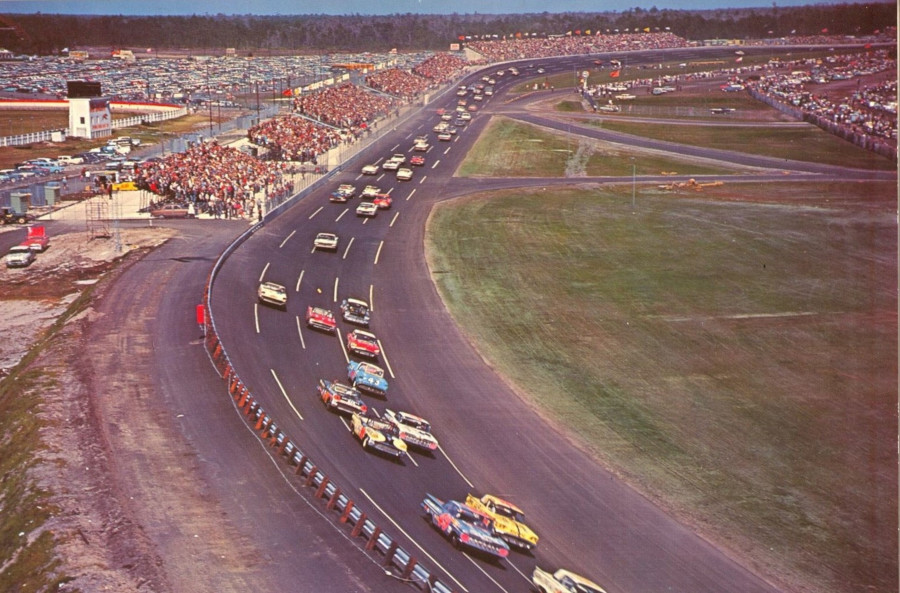by A. Wayne Ferens
Images Courtesy of the Ferens Collection
Published 8-30-2023
 Lee Petty in the #42 Oldsmobile and Joe Weatherly battle in the tight sand turns of the Daytona Beach & Road course. Petty went on to finish 2nd in the 1958 (and last) convertible beach race. (Photo: Ferens Collection)
Lee Petty in the #42 Oldsmobile and Joe Weatherly battle in the tight sand turns of the Daytona Beach & Road course. Petty went on to finish 2nd in the 1958 (and last) convertible beach race. (Photo: Ferens Collection)
From the earliest days of the automobile, all cars were open, evolving from the horse drawn buggy or carriage. The earliest forms of automobile competition were mostly done in open type cars. Weather was not a primary concern, but durability was. As early as 1903, automobiles were competing on the Ormond and Daytona Beaches, and by the 1920s and 30s, the hard sands of Daytona became the preferred location for land speed records.
The National Association for Stock Car Auto Racing, Inc. (NASCAR), a formal sanctioning organization was founded on February 21, 1948 by Bill France with the help of several other drivers and organizers to establish a unified series of racing competitors with original plans that included Modified, Roadster and Strictly Stock Divisions. It soon became apparent the fans were not interested in competing roadsters, and that division was abandoned. As the car market changed during the 1950s with the growing popularity of small 'drop top' imports and the introduction of new stylish convertible cars from Detroit, NASCAR decided to establish a competition strictly for convertibles. Ford dominated convertible sales in the 50s as it had in the 30s, and by 1957, convertible sales in the United States reached 5 percent of the total car market.
 An early NASCAR race program cover featuring driver Gwyn Staley
An early NASCAR race program cover featuring driver Gwyn Staley
The NASCAR Convertible Division was established with the purchase of SAFE (Society of Auto Sports, Fellowship and Education)'s all-convertible Circuit of Champions "All Stars" circuit in late 1955 and ran the division through 1959. The signature race for convertibles remained a Convertible Division race until 1962, with the first being run under NASCAR at Daytona Beach on February 25, 1956. On Saturday, February 22, 1958, the last Convertible Series Race was held on the Daytona Beach & Road Course. It was part of the NASCAR Grand National Series.
 A news clipping about the NASCAR merger
A news clipping about the NASCAR merger
For two weeks each February, the beach came alive for Daytona visitors with a series of festivities, races and events that were organized to both thrill and entertain over 20,000 fans. Stock cars, race cars, family cars and manufacturers’ latest production vehicles and prototypes were on full display to whet the appetite of the car enthusiast. The most popular event was the Measured Mile Run that amateurs and professionals alike could participate in -- even using their everyday family driver to compete. The Daytona Beach & Road Course was a defined circuit that ran north on the 200-foot wide hard sandy beach surface and south on the asphalt paved two-lane section of Florida's Highway A1A. The short tight turns were located at the north and south ends of the 4.1 mile road course.
 The Daytona Beach & Road Course was last used in 1958. Looking south, Florida Hwy A1A on the right was paved asphalt. Photo: Ferens Collection)
The Daytona Beach & Road Course was last used in 1958. Looking south, Florida Hwy A1A on the right was paved asphalt. Photo: Ferens Collection)
The 1958 Convertible Series race (one of 19 races) was the Daytona Beach windup race that ran for 39 laps, a total distance of 159.9 miles, with 29 cars entered. The cars competing were required to be strictly stock factory cars with the engines limited to one four-barrel carburetor. With safety in mind, the cars were permitted by NASCAR to make wheel, brake, steering and suspension reinforcements, but did require a 22-gallon limited fuel capacity, roll bar, seat belts and helmet for the driver. The greatest drivers in the world, including Lee Petty, Curtis Turner, Joe Weatherly, Buck Baker and Fireball Roberts driving the hottest convertibles from Ford, Chevy, Plymouth, Pontiac, Edsel, Olds and Mercury with 300 plus horsepower, thrilled the crowds with speeds of over 140 mph on the straights.
 Curtis Turner in the Holman-Moody 1958 Ford winning convertible at the last Daytona Beach & Road Course race. Turner's motto was: "Run flat out until it breaks or wins," and win he did. Turner averaged 99 mph and received $4,000 for his efforts. (Photo: Ferens Collection)
Curtis Turner in the Holman-Moody 1958 Ford winning convertible at the last Daytona Beach & Road Course race. Turner's motto was: "Run flat out until it breaks or wins," and win he did. Turner averaged 99 mph and received $4,000 for his efforts. (Photo: Ferens Collection)
At the start of the 1958 NASCAR Grand National season, automakers faced the Automobile Manufacturers Association 1957 ban on active participation in racing. To abide by the AMA resolution, the manufacturers had to be creative and discrete in getting their latest performance equipment into the hands of the NASCAR competitors. Race car builders Holman-Moody and Wood Brothers Racing, engine builders like Smokey Yunick and dealers like Jim Rathmann Chevrolet in Florida became “partners” and sponsors with the race teams so none of the performance parts, equipment, body modifications and tuning secrets would come directly from the factories in violation of the AMA agreement. The winner of the 1958 Convertible Series and the last Daytona Beach race was Curtis Turner in the #26 Ford that was courtesy of 32 Carolina Ford dealerships, not the Ford factory. The Convertible Series became a big hit with the fans because they could see the drivers wheeling around the track, and the cars reflected the production vehicles that could be purchased at their local dealership.
 Bob Welborn with his 1957 Chevrolet championship car #49. Welborn was acknowledged as the king of the convertibles, winning 19 of the 117 races. He also drove Grand National cars for Julian Petty, Lee's brother. (Photo: Ferens Collection)
Bob Welborn with his 1957 Chevrolet championship car #49. Welborn was acknowledged as the king of the convertibles, winning 19 of the 117 races. He also drove Grand National cars for Julian Petty, Lee's brother. (Photo: Ferens Collection)
Bob Welborn was the undisputed king of the NASCAR Convertible Division championship, winning three years in a row from 1956 to 1958. Welborn (1928-1997) was named one of NASCAR's 50 greatest drivers in 1996. Joe Lee Johnson won the final convertible championship in 1959, just as NASCAR dropped the series. That year, Bill France Sr. opened the new Daytona Speedway just a short distance from the beach. However, some tracks continued to run convertible events through 1962.
 In 1956, Ford Motor Company hired John Holman to run their factory team shop in Charlotte, NC. Holman and Ralph Moody, who drove in NASCAR in 1956 and 1957, formed a partnership after the AMA banned Ford's factory participation in stock car racing in June 1957. H&M Fords won their first two races in 1957, and the rest is history. (Photo: Ferens Collection)
In 1956, Ford Motor Company hired John Holman to run their factory team shop in Charlotte, NC. Holman and Ralph Moody, who drove in NASCAR in 1956 and 1957, formed a partnership after the AMA banned Ford's factory participation in stock car racing in June 1957. H&M Fords won their first two races in 1957, and the rest is history. (Photo: Ferens Collection)
 The 1959 Daytona 500 had one qualifying race for Convertibles and one for the hardtop Grand National cars. 20 of the 59 cars in the 500 miler were convertibles. Some teams ran so-called "zipper top" cars that had a fabricated or modified bolt-on removable metal top that could run in either the Grand National or the Convertible Division series. The 31-degree banking at the 2.5 mile speedway was the steepest of any track at the time. With 41,921 trackside fans and average speeds in excess of 135 mph, Daytona’s new speedway was quickly established as the fastest track on the NASCAR circuit. Joe Lee Johnson won the last NASCAR Convertible race at Daytona. (Photo: Ferens Collection)
The 1959 Daytona 500 had one qualifying race for Convertibles and one for the hardtop Grand National cars. 20 of the 59 cars in the 500 miler were convertibles. Some teams ran so-called "zipper top" cars that had a fabricated or modified bolt-on removable metal top that could run in either the Grand National or the Convertible Division series. The 31-degree banking at the 2.5 mile speedway was the steepest of any track at the time. With 41,921 trackside fans and average speeds in excess of 135 mph, Daytona’s new speedway was quickly established as the fastest track on the NASCAR circuit. Joe Lee Johnson won the last NASCAR Convertible race at Daytona. (Photo: Ferens Collection)
 Joe Lee Johnson in his winning 1957 Chevrolet convertible. (Photo: Ferens Collection)
Joe Lee Johnson in his winning 1957 Chevrolet convertible. (Photo: Ferens Collection)
 Lee Petty's 1957 Oldsmobile #42 with removable "zipper top" ran in both the hardtop Grand National and the Convertible Division races. (Photo: Ferens Collection)
Lee Petty's 1957 Oldsmobile #42 with removable "zipper top" ran in both the hardtop Grand National and the Convertible Division races. (Photo: Ferens Collection)
Bibliography
Fielden, Greg. “Forty Years of Stock Car Racing.” 1993.
Motor Trend Magazine, May 1959.



